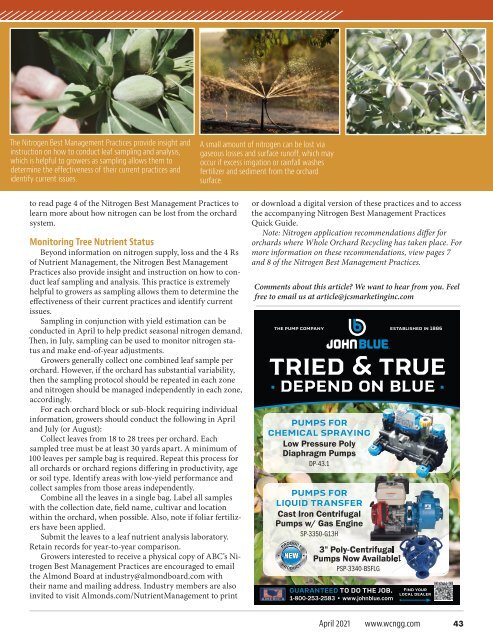Create successful ePaper yourself
Turn your PDF publications into a flip-book with our unique Google optimized e-Paper software.
The Nitrogen Best Management Practices provide insight and<br />
instruction on how to conduct leaf sampling and analysis,<br />
which is helpful to growers as sampling allows them to<br />
determine the effectiveness of their current practices and<br />
identify current issues.<br />
A small amount of nitrogen can be lost via<br />
gaseous losses and surface runoff, which may<br />
occur if excess irrigation or rainfall washes<br />
fertilizer and sediment from the orchard<br />
surface.<br />
to read page 4 of the Nitrogen Best Management Practices to<br />
learn more about how nitrogen can be lost from the orchard<br />
system.<br />
Monitoring Tree <strong>Nut</strong>rient Status<br />
Beyond information on nitrogen supply, loss and the 4 Rs<br />
of <strong>Nut</strong>rient Management, the Nitrogen Best Management<br />
Practices also provide insight and instruction on how to conduct<br />
leaf sampling and analysis. This practice is extremely<br />
helpful to growers as sampling allows them to determine the<br />
effectiveness of their current practices and identify current<br />
issues.<br />
Sampling in conjunction with yield estimation can be<br />
conducted in <strong>April</strong> to help predict seasonal nitrogen demand.<br />
Then, in July, sampling can be used to monitor nitrogen status<br />
and make end-of-year adjustments.<br />
Growers generally collect one combined leaf sample per<br />
orchard. However, if the orchard has substantial variability,<br />
then the sampling protocol should be repeated in each zone<br />
and nitrogen should be managed independently in each zone,<br />
accordingly.<br />
For each orchard block or sub-block requiring individual<br />
information, growers should conduct the following in <strong>April</strong><br />
and July (or August):<br />
Collect leaves from 18 to 28 trees per orchard. Each<br />
sampled tree must be at least 30 yards apart. A minimum of<br />
100 leaves per sample bag is required. Repeat this process for<br />
all orchards or orchard regions differing in productivity, age<br />
or soil type. Identify areas with low-yield performance and<br />
collect samples from those areas independently.<br />
Combine all the leaves in a single bag. Label all samples<br />
with the collection date, field name, cultivar and location<br />
within the orchard, when possible. Also, note if foliar fertilizers<br />
have been applied.<br />
Submit the leaves to a leaf nutrient analysis laboratory.<br />
Retain records for year-to-year comparison.<br />
Growers interested to receive a physical copy of ABC’s Nitrogen<br />
Best Management Practices are encouraged to email<br />
the Almond Board at industry@almondboard.com with<br />
their name and mailing address. Industry members are also<br />
invited to visit Almonds.com/<strong>Nut</strong>rientManagement to print<br />
or download a digital version of these practices and to access<br />
the accompanying Nitrogen Best Management Practices<br />
Quick Guide.<br />
Note: Nitrogen application recommendations differ for<br />
orchards where Whole Orchard Recycling has taken place. For<br />
more information on these recommendations, view pages 7<br />
and 8 of the Nitrogen Best Management Practices.<br />
Comments about this article? We want to hear from you. Feel<br />
free to email us at article@jcsmarketinginc.com<br />
<strong>April</strong> <strong>2021</strong> www.wcngg.com 43


















